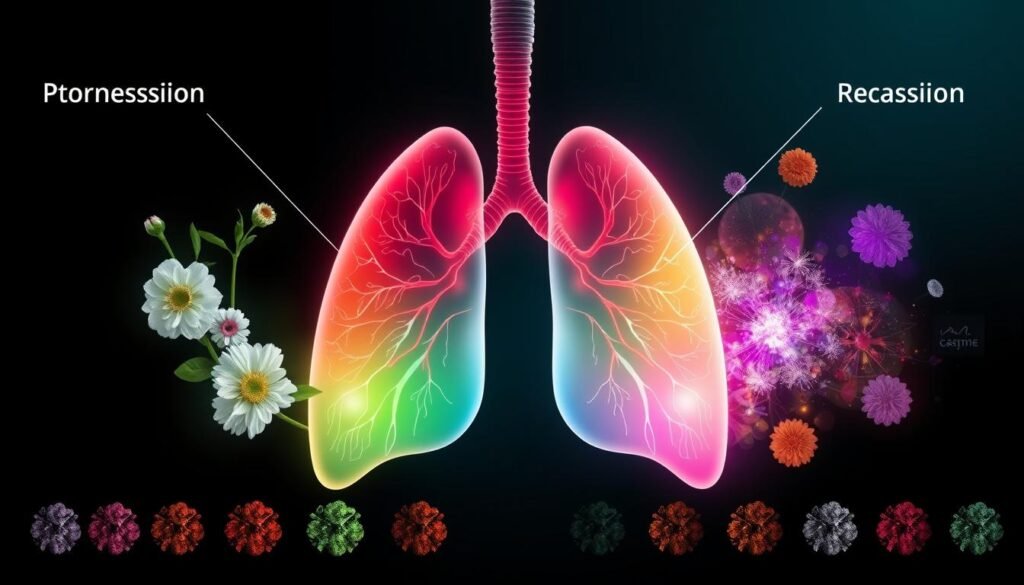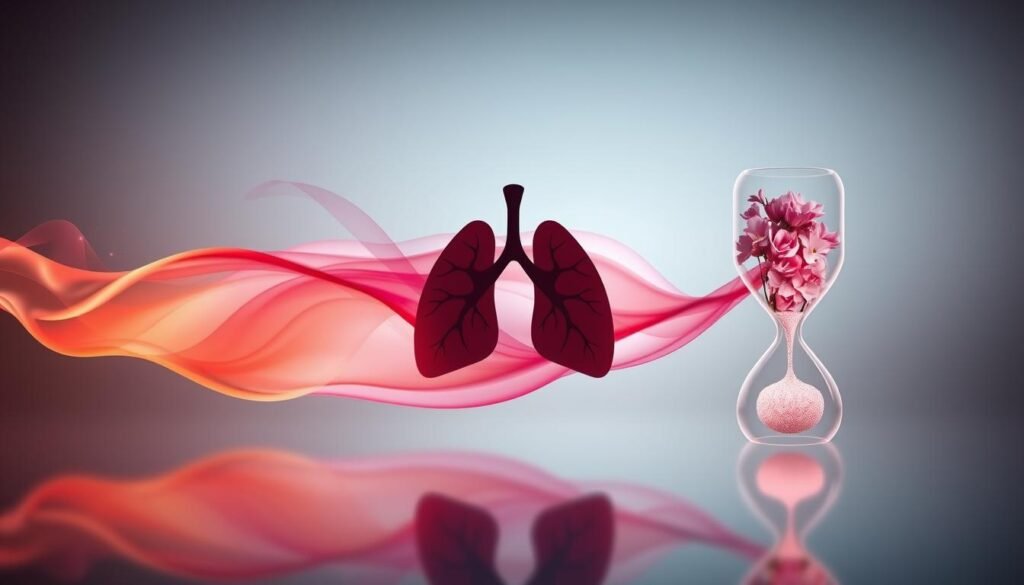Did you know that nearly 50% of patients with non-small cell lung cancer (NSCLC) may experience remission with targeted therapy? This fact raises key questions about the remission duration in lung cancer. It also affects patient life. Remission means the signs and symptoms of cancer have reduced or disappeared. This is an important step in the patient’s journey. Although remission isn’t a full cure, it often leads to a better outlook and life quality.
This article will discuss the remission period of lung cancer. It will help patients and their families know what to expect after treatment. Knowing about factors like age, health, and lifestyle choices helps in navigating this journey. Actions, such as quitting smoking, can greatly improve the chances of staying cancer-free. For more on remission, check this patient guide.
Key Takeaways
- Understanding lung cancer remission is crucial for patients post-treatment.
- Complete and partial remissions indicate varying responses to treatment.
- Lung cancer remission duration can last from months to years.
- Factors like lifestyle changes can enhance the chances of long-term remission.
- Statistics suggest significant possibilities for remission with targeted therapies.
- Reductions in smoking and alcohol intake may positively influence remission periods.
Understanding Lung Cancer Remission
Understanding lung cancer remission is crucial for patients and their loved ones. It means a significant decrease in cancer signs and tumor size, seen through medical scans. This journey toward remission relies on treatments that kill cancer cells, offering hope for a longer life.
Partial remission means the tumor has shrunk by at least 50 percent. Complete remission means no tumors are found. Lung cancer rarely goes into spontaneous remission, unlike some other cancers. Even in remission, patients need regular check-ups. This is because cancer can come back.
The lung cancer prognosis differs greatly based on the cancer type and treatment success. For example, 23 percent of non-small cell lung cancer patients live at least five years after treatment. This stat shows why it’s vital to keep a close eye on health post-treatment.
Being cured means there are no tumors left and no chance of cancer coming back. Remission means the opposite. Symptoms may have stopped, but cancer might still be hiding. Knowing the difference helps in managing expectations and planning for the future.
Types of Lung Cancer Remission
It’s crucial for patients and their families to understand lung cancer remission types. There are three main types: complete, partial, and spontaneous remission. Each type shows different results from treatment, impacting a patient’s future planning and hope.
Complete Remission
In complete remission, scans show no sign of disease. Patients seem cancer-free, bringing great relief. This phase is a big step in recovering, offering patients a chance to live with more hope.
Partial Remission
Partial remission means cancer is still there but tumors are smaller. This shows treatment is working. It’s a hopeful sign for patients on their healing path.
Spontaneous Remission
Spontaneous remission is cancer going away on its own, with no treatment. It’s very rare but fascinating. It’s the exception, not the common outcome.

Understanding lung cancer remission types is key for patients post-treatment. For more details, check out this resource here.
How Long Can Lung Cancer Stay in Remission
Lung cancer remission time varies with cancer type and patient factors. It’s key for patients and families to know how long remission might last. Non-Small Cell Lung Cancer (NSCLC) and Small Cell Lung Cancer (SCLC) have different remission times. This affects decisions related to treatment and future planning.
Duration of Remission for NSCLC
The outlook for NSCLC remission is hopeful for many. Studies show that about 57% of NSCLC patients stay in remission for over two years post-treatment. Catching the cancer early and starting treatment soon helps increase the chances of long-lasting remission. However, the risk of the cancer coming back after surgery for NSCLC varies. It can be between 30% and 75%, based on factors like the stage of cancer when found.
Duration of Remission for SCLC
SCLC tends to have shorter remission periods compared to NSCLC. Most people with SCLC have remission that lasts less than a year. While up to 80% might reach remission, the cancer often returns quickly, usually within two years.
There are treatments aimed at keeping this aggressive cancer at bay. But, the outlook when it comes back can be tough.

| Type of Lung Cancer | Average Remission Duration | Recurrence Rate |
|---|---|---|
| NSCLC | Over 2 years (57% of patients) | 30-75% |
| SCLC | Less than 1 year | 80% |
Knowing about lung cancer remission helps patients and caregivers have clear expectations. They can make better plans for care and support. Every patient’s experience is different. This shows how tailor-made treatment plans and ongoing talks with doctors are vital.
Lung Cancer Remission Rates
Lung cancer remission rates show us how likely patients are to recover. This includes those with non-small cell lung cancer (NSCLC) or small cell lung cancer (SCLC). About 57% of NSCLC patients stay in remission for at least two years. Yet, only around 27% of SCLC patients see similar results after treatment.
Many factors affect these remission rates. They include the cancer type, how early it was caught, and the treatment methods. Knowing these rates shows the value of catching lung cancer early for better treatment success. Early-stage diagnosis usually results in much better survival rates.
The stage of cancer at diagnosis affects survival chances significantly. People with cancer found early often live longer than those with more advanced stages. However, the five-year survival rate for all lung cancer types is around 18.6%. This low rate is due to just 16% of the cases being detected early.
To improve remission rates, more screening is necessary. The U.S. Preventive Services Task Force suggests yearly screenings for those at high risk. This could raise survival rates. Sadly, fewer than 6% of those eligible get screened. This leads to more cases being found too late.
Treatment Options for Achieving Remission
There are various treatment options for lung cancer aiming for remission. The treatment choice largely depends on the lung cancer type, stage, and patient’s health. Some key treatments may effectively lead to remission.
Surgery
Surgery is often the top choice for treating non-small-cell lung cancer (NSCLC) in early stages. It aims to fully remove the tumor, aiding in remission. Yet, it’s not an option for all due to advanced cancer or poor lung function. Surgery also helps ease symptoms in some cases.
Chemotherapy
Chemotherapy uses drugs to destroy cancer cells. It treats both NSCLC and small-cell lung cancer (SCLC). Being a systemic treatment, it’s sometimes used with other treatments. The treatment plan depends on the cancer stage and patient health, helping control the tumor and aim for remission.
Radiation Therapy
Radiation therapy involves high-energy beams to reduce tumors. Often paired with chemotherapy, it’s vital when surgery isn’t an option. It focuses on controlling the tumor size and reducing symptoms, especially in late-stage lung cancer.
Immunotherapy
Immunotherapy, which boosts the immune system to fight cancer, is becoming popular. It’s promising for cancers with certain genetic features. Drugs like pembrolizumab and cemiplimab have shown to extend life and enhance patient quality of life, offering hope to those who might not benefit from conventional treatments.

| Treatment | Target Cancer Type | Objective | Common Stages |
|---|---|---|---|
| Surgery | NSCLC | Remove tumor | Stage 0, I |
| Chemotherapy | NSCLC, SCLC | Kill cancer cells | All stages |
| Radiation Therapy | NSCLC, SCLC | Shrink tumors | All stages |
| Immunotherapy | NSCLC | Stimulate immune response | Advanced stages |
Factors Influencing Lung Cancer Remission
Understanding what affects lung cancer remission is vital for patients on their treatment path. Factors such as age and health status greatly influence how a patient responds to treatments. Additionally, how one lives plays a huge role in improving their overall health.
Age and Overall Health
Younger patients often see better results in remission. Those in good health can handle tougher treatments, boosting their remission chances. The mix of a patient’s age and health affects treatment choices and their recovery.
Lifestyle Choices
For lung cancer patients, living healthily is key. Eating well, exercising, and getting enough sleep strengthen the body’s defense against cancer. These healthy habits significantly affect how someone manages lung cancer in the long run.
Quit Smoking
Stopping smoking is crucial in cancer care and healing. Patients who quit smoking improve their overall health. This boosts how well they respond to treatments, possibly extending their remission period. Quitting smoking is a major step towards recovery and supports the body’s healing.
Managing Lung Cancer Remission
Reaching remission from lung cancer marks a crucial point in a patient’s journey. To manage this remission, staying alert and proactive is key. Regular check-ups help catch any recurrence early. At first, patients should have follow-up visits every three months. Over time, these visits will become less frequent.
Lifestyle changes also play a big part in keeping cancer at bay. Adopting healthy habits is encouraged to support overall health. Eating well, staying active, and managing stress are important. It is also vital to take care of your mental health. This can include talking to a therapist or joining support groups where patients can share their stories and find comfort.
Stopping smoking is another critical step in staying in remission. People who beat lung cancer but smoke are at higher risk of getting it again. Making positive changes in your lifestyle is thus very important. Being informed about your health helps you make smart choices and seek help when needed. This keeps you active in your care plan.
Here is a breakdown of key parts in managing lung cancer remission:
| Component | Description |
|---|---|
| Regular Check-ups | Required every 3 months initially, gradually increasing to yearly visits. |
| Lifestyle Adjustments | Incorporate a balanced diet, physical activity, and stress relief practices. |
| Emotional Support | Access to mental health resources and engagement in support groups. |
| Smoking Cessation | Critical in enhancing survival and lowering chances of a second lung cancer. |
| Continued Education | Patients should stay updated on health information to make informed choices. |
By focusing on these key areas, patients can lead their health journey. This enhances life quality while effectively managing lung cancer remission.
Lung Cancer Recurrence After Remission
It’s vital to understand the chance of lung cancer coming back after remission. Patients and their families need this knowledge. It helps them watch for signs and manage their health better. Knowing about recurrence shapes treatment choices, so recognizing patterns and stats is key.
Statistics on Recurrence for NSCLC
About 60% of people with non-small cell lung cancer (NSCLC) will see it return within five years after treatment. The stage of cancer at diagnosis affects the likelihood of return. For example, stage 1 has around a 30% relapse rate, while stage 4 jumps to 70%. Often, cancer comes back in distant organs, leading to a median survival time of about 21 months.
Statistics on Recurrence for SCLC
Small cell lung cancer (SCLC) has even higher chances of returning, with over 90% of patients facing relapse within two years. SCLC’s aggressiveness highlights the need for close watch and proactive care. Sadly, the outlook isn’t great, with many patients living only about six months after it comes back. Staying informed and seeking treatments like chemotherapy or immunotherapy is critical for those with NSCLC or SCLC.
Learn how to manage taste changes during treatment here. It’s important to look after every element of lung cancer treatment.